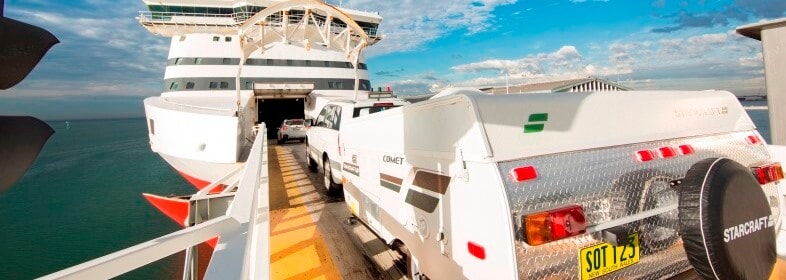How does booking a motorhome/campervan differ to booking a caravan?
'Motorhome' means a road vehicle designed and constructed primarily to provide sleeping accommodation for the number of occupants that the vehicle is designed to carry. A motorhome is also referred to as a campervan. When making your booking, you need to book the motorhome or campervan as a vehicle and at the vehicle step, select the motorhome/campervan option.
A 'caravan' is a unit which is designed and constructed primarily to provide sleeping accommodation. However it is a separate non-motorised unit and therefore must be towed by a motorised unit in order to be transported. When booking your caravan, you need to select the 'towing a caravan or trailer' option. You will need to provide the full length of your vehicle from end to end. The length includes the caravan and attachments such as a drawbar, bike racks, gas cylinders etc.
How do I measure my vehicle?
Please measure the full length of your vehicle from end to end. You need to provide measurement details for your vehicle to ensure that you are charged the correct price. Vehicle sizes are subject to confirmation on check-in and if the incorrect details have been provided you may be charged an extra fee.
Measuring length
The total length of your vehicle including towed items (caravan, camper trailer or trailer) and attachments (drawbar, bike racks, gas cylinders etc.) must be included in the total measurement.
Please ensure the total length is measured correctly to ensure you are charged the correct price.
Measuring height
The total height of your vehicle including towed items (caravan, camper trailer or trailer), roof racks and any additional items stored on the roof of the vehicle (kayaks, baggage, bicycles etc.) must to be included in the total measurement.
Please ensure the total height is measured correctly and the correct height is selected at the time of booking. Whilst there is no additional cost attached to vehicle height, providing the correct height assists with vehicle loading and ensures you are parked on the correct vehicle deck. Failure to advise the correct height may result in your passage being denied at check-in if there is insufficient vehicle space on the required vehicle deck.
What happens with gas bottles?
If your gas bottle is fixed to your vehicle (fixed via a bracket or compartment) they are permitted to travel in your vehicle as long as they are turned OFF.
If you have a standard passenger vehicle with a Gas Bottle or Butane Canisters loose and not in their original packaging contained within the vehicle, the item will be deposited with security, tagged with your passenger details including booking number and can be collected upon disembarkation.
All loose gas bottles including butane cylinder canisters, (subject to quantities deemed as personal use and not for commercial use),can remain in the passenger accompanies vehicle providing:
Standard vehicles & open trailers – one bottle (maximum size 9 litres (25L) capacity.
Caravan’s / Motor home / Campers / Etc. – ONE additional bottle (maximum size 25 kg (50 litre water capacity).
-Gas bottle is secure within/on the vehicle.
-Gas bottle is secured in the upright position.
-Gas bottle is turned off.
-Check gas bottle is within validation.
All Gas Bottles that meet the aforementioned conditions will be tagged with a “HAZARD” tag to ensure the gas bottle is not turned on whilst the gas bottle is within TT-Line’s terminals or onboard a TT-Line vessel and remain with the passenger accompanied vehicle.
Gas Bottles that do not meet the aforementioned conditions will either be confiscated and disposed of if validation has expired, or will be deposited and collected upon disembarkation.
You can read further information about Carriage of Dangerous Goods here
Can I travel with my jerry can or fuel?
Jerry Cans and Boat Fuel Containers (subject to quantities deemed as personal use and not for commercial use), can be only be transported on the basis of:-
-Jerry Cans and Boat Fuel Containers filled with diesel ONLY can be transported.
-Jerry Cans and Boat Fuel Containers filled with other dangerous fuel eg petrol, aviation fuel and non-standard fuels are prohibited from carriage.
-Jerry Cans and Boat Fuel Containers containing diesel must be fully welded at seams (Plastic or Metal).
-Jerry Cans and Boat Fuel Containers containing diesel must not be greater than 50 litre capacity.
-Sealing cap has locking side arms or screwed cap with an effective rubber seal.
-All other than Jerry Cans and Boat Fuel Containers must be empty and dry of residual liquid.
In the event petrol residual is identified inside an empty Jerry Can or Boat Fuel can, the passenger must fill the container with water before being allowed to travel. You can read further information about Carriage of Dangerous goods here
Carriage of oxygen cylinders and compressed air cylinders
Compressed Air Cylinders (includes scuba tanks) can be carried under the following conditions;
-Full cylinders are to be removed from vehicles and secured in the gas trolley
-For cylinders to remain in the confines of vehicles or other positions of the vehicle deck (outside the confines of the gas trolley), the pressure must be released such that the maximum pressure reading is 40 psi.
-Other Cylinders containing compressed oxygen (e.g. oxy – welding O2 bottles) cannot be carried



